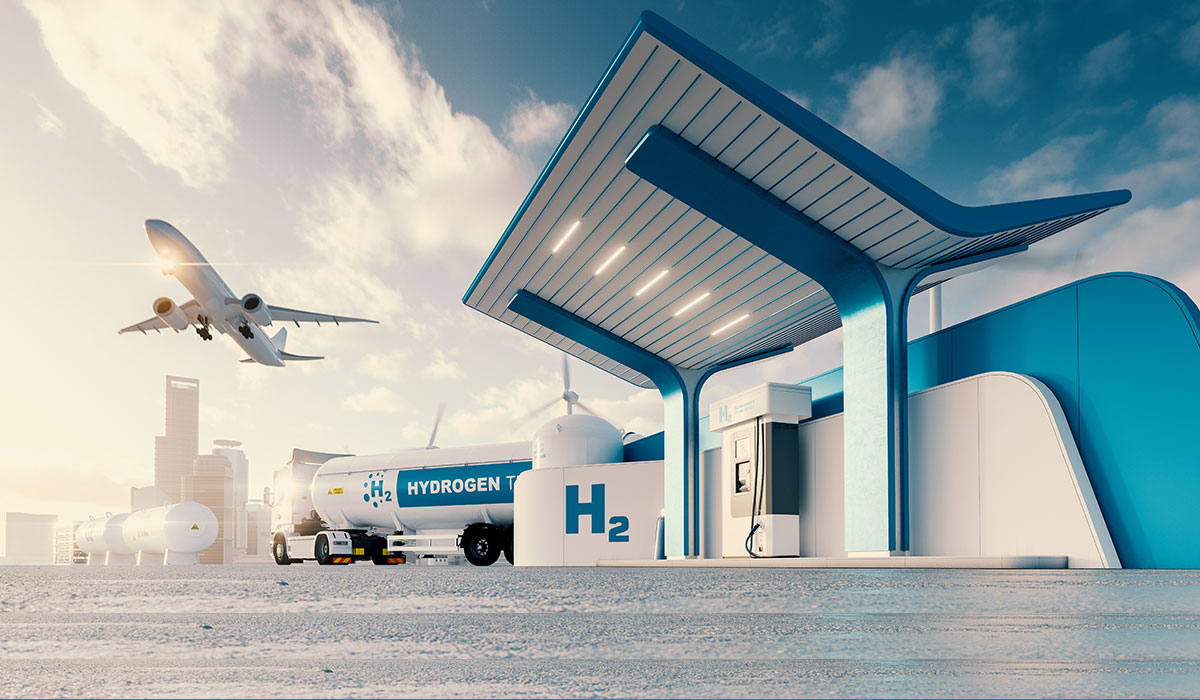


We need to make the use of hydrogen more accessible where it is needed the most: in heavy-duty vehicles, in aviation and in shipping (trucks, trains, aeroplanes and ships).
In France, transport accounts for 31% of greenhouse gas emissions and is the highest emitting sector in the country. Green hydrogen offers real opportunities for tomorrow's zero-carbon mobility solutions because it does not emit pollutants or cause noise pollution. Quentin Nouvelot and Sécil Torun, experts at ENGIE Lab CRIGEN, share their experience in this strategic field and explain the progress needed for it to be rolled out across the transport sector.
Hydrogen addresses one key challenge: air quality and zero CO2 emissions on a local level. It is a key sector in the energy transition towards more sustainable mobility. In fact, hydrogen-powered vehicles, which get their energy from fuel cells, only emit water. Renewable hydrogen is therefore the only technical solution available today that can decarbonise transport on a local level for certain uses: road transport, particularly heavy goods vehicles, shipping and aviation offer a vast scope of application for hydrogen. But its cost remains high compared with fossil fuel-powered vehicles, which is why the primary goal is to reduce costs so that green or low-carbon hydrogen can be more competitive by 2030, depending on the type of vehicle and application.
Renewable or green hydrogen, produced through water electrolysis, is the missing link in the implementation of the energy transition. According to the Hydrogen Council, the gas can contribute 20% of the total abatement of carbon emissions set by the Paris Agreement.
We face three key challenges: development of hydrogen distribution networks, industrialisation, and market standardisation. Currently transported primarily by lorry and restricted to one tonne per vehicle, hydrogen needs new modes of transport and storage if it is to become more widely accessible. On-site production - hydrogen charging stations, industrial plants - goes some way to addressing this problem.
Hydrogen charging facilities require large investments but are necessary if this energy source is to be rolled out on a large scale. To achieve this, we need to analyse the different components of a charging station and its operational features. This is where the specialist expertise developed by ENGIE Lab CRIGEN, the Group's R&D centre in Paris, comes in: we are modelling the stations to identify their weak points and develop innovative systems to reduce investment and operating costs.
A large ecosystem of energy suppliers, equipment manufacturers and network designers are also working to define the best practices in these fields. The aim is to set a standard for this type of operation so that, eventually, anyone can install charging stations for all types of vehicles with correct charging protocols safely in place.
For example, ENGIE Lab CRIGEN is involved in PRHYDE, a European project to study the current developments and future innovations needed for refuelling hydrogen-powered medium and heavy-duty vehicles, mainly for road transport but also for other applications such as rail and shipping.
We need to make the use of hydrogen more accessible where it is needed the most: in heavy-duty vehicles, in aviation and in shipping (trucks, trains, aeroplanes and ships). ENGIE Lab CRIGEN worked on using renewable hydrogen to power a passenger train in the north of the Netherlands, the first project of its kind in the world. Its models helped to establish the required loading time and to fully understand each operation, such as identifying the right temperature or pressure conditions under safe conditions. ENGIE Lab CRIGEN's renowned excellence enables us to work alongside a large ecosystem of partners and start-ups, focusing on operational and safety factors, with a view to rolling out this type of hydrogen-powered train in the Netherlands, Germany, France and the rest of Europe.
Our researchers are also currently working on two other sectors: aviation and shipping. For these industries, they are focusing on liquid hydrogen. Through a partnership with Ariane Group, ENGIE is developing hydrogen liquefaction technology to decarbonise the sector. Lab CRIGEN is working on the very early stages of the project - developing and commercialising the technology in order to roll out hydrogen-based mobility across the sector. The Group is also involved further downstream with energy supply, network provision, tank loading operations, and the logistics required for supplying these hydrogen stations. It will thus be possible to use hydrogen in either liquid or gas form, depending on its different mobility and logistics applications, in both airports and ports.
The final research focus is e-fuels: converting renewable energy into different types of fuel by producing green hydrogen and combining it with CO2 and nitrogen to form e-methanol or e-kerosene, for example. Here too, our expertise enables us to address a considerable challenge faced by the aviation industry: finding fuels that emit less CO2 by using a proportion of green hydrogen. This is another line of research that is developing rapidly.
To address these challenges, we created the H2 Factory, a unique testing platform comprising both an electrolyser to produce hydrogen and storage capacity with a compressor. The aim is to use the platform to run the pilot tests and technology needed for our different European projects. We hope that our ecosystem of partners will also use it to test their technology. We will then be able to run test campaigns across the entire value chain.
Standardisation of these new markets will play a vital role in boosting confidence and safety throughout the sector. However, it is a complex sector with very different consumption levels: a long-haul aircraft does not consume the same amount of energy as its short-haul counterpart, just as a short sea vessel does not use the same quantity as a transoceanic ship. Energy requirements are not the same and hydrogen in gas form will not be sufficient. Liquid hydrogen, or another energy vector containing green hydrogen, will therefore be needed. We need to think up new channels and networks to help these sectors grow - creating large-scale infrastructure, supplying the cheapest possible molecule to make hydrogen-powered heavy mobility a reality - by working with strategic partners and ensuring a standardised framework.
At ENGIE Lab CRIGEN, we helped set ISO and CEN2 standards on hydrogen stations and are now working on a filling protocol standard, designed to meet the needs of all types of vehicles, set standards and ensure interoperability of stations and vehicles. We are helping to create the regulatory package currently being drawn up by the CNH2 (Spanish National Hydrogen Centre), in which both ENGIE and the French government are participating. The package aims to lift a number of regulatory barriers over the next 12 months and, in so doing, help develop the sector.
It is also crucial to focus on the quality and performance of hydrogen, to ensure a reliable energy vector for the most people possible. At ENGIE Lab CRIGEN, we conduct quality analyses at refuelling stations using sampling tools that are specific to ENGIE, thereby guaranteeing that the hydrogen supplied at ENGIE stations complies with applicable standards.
Finally, safety is a key factor in the rollout of hydrogen for use by the general public. We must continue to study the risks associated with hydrogen, which are not the same as those posed by fossil fuels, and work with the entire industry to adopt the good practices that will guarantee a safe hydrogen sector.
ENGIE supports regions on several levels, by developing hydrogen-based mobility solutions, by helping regions introduce them (ENGIE already operates about fifteen stations and aims to reach 100 stations by 2030), and by working on Research & Development projects needed to make hydrogen accessible to as many people as possible. At the ENGIE Lab specialising in hydrogen, about thirty people - PhD students, research engineers and employees on work/study contracts - work with the other ENGIE Lab CRIGEN labs, because hydrogen is an energy vector with different applications. With the Industry Lab, for example, we are researching solutions for decarbonising industrial systems. Meanwhile, with the Cities & Regions Lab,, we are working on a 100% hydrogen district capable of generating electricity and heat on a neighbourhood scale.
The aim is to address the entire hydrogen value chain – production, transport, storage, distribution, and development of its different applications, as well as safety and standardisation – to find all existing hydrogen production systems and reduce costs enough for hydrogen to penetrate certain industry sectors. We adopt a partnership approach with all players in our ecosystem, encouraging a ship-owner, for example, to make investments over a period of thirty years in a ship that must comply with requirements to cut CO2 emissions. The ship-owner wants a guarantee that they will be able to refuel safely in all the ports the ship is due to dock in. And yet, today, one of the main obstacles to widespread rollout of hydrogen lies in the necessary development of networks to enable large-scale, competitively-priced production of the fuel.
The widespread rollout of hydrogen concerns everyone and will be achieved through collective engagement on the part of energy operators, industry players in the sector, and regions. While technological solutions are mature, scaling up is of strategic importance for reducing costs and thereby enabling the sector to develop through professionalisation and improvements in operational excellence and performance.